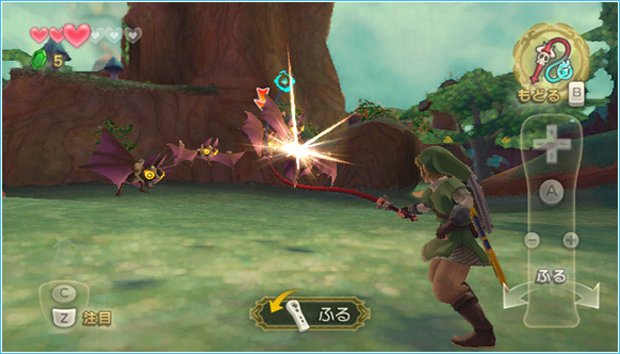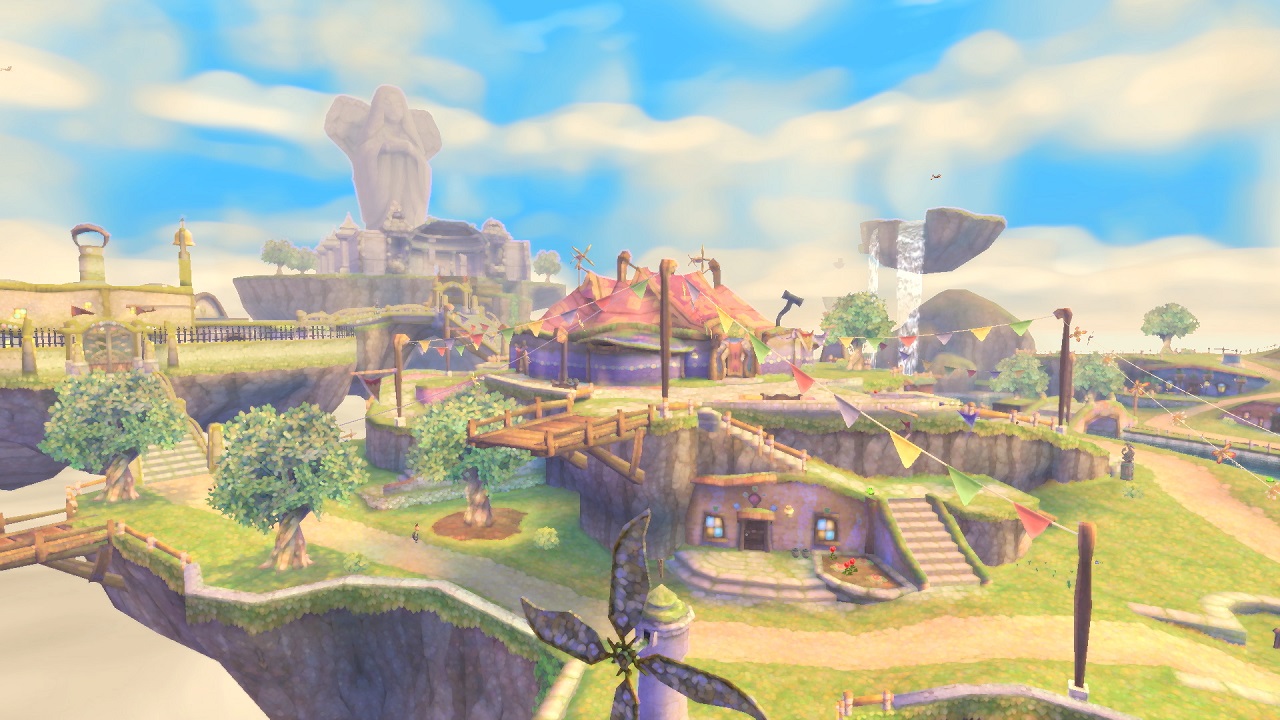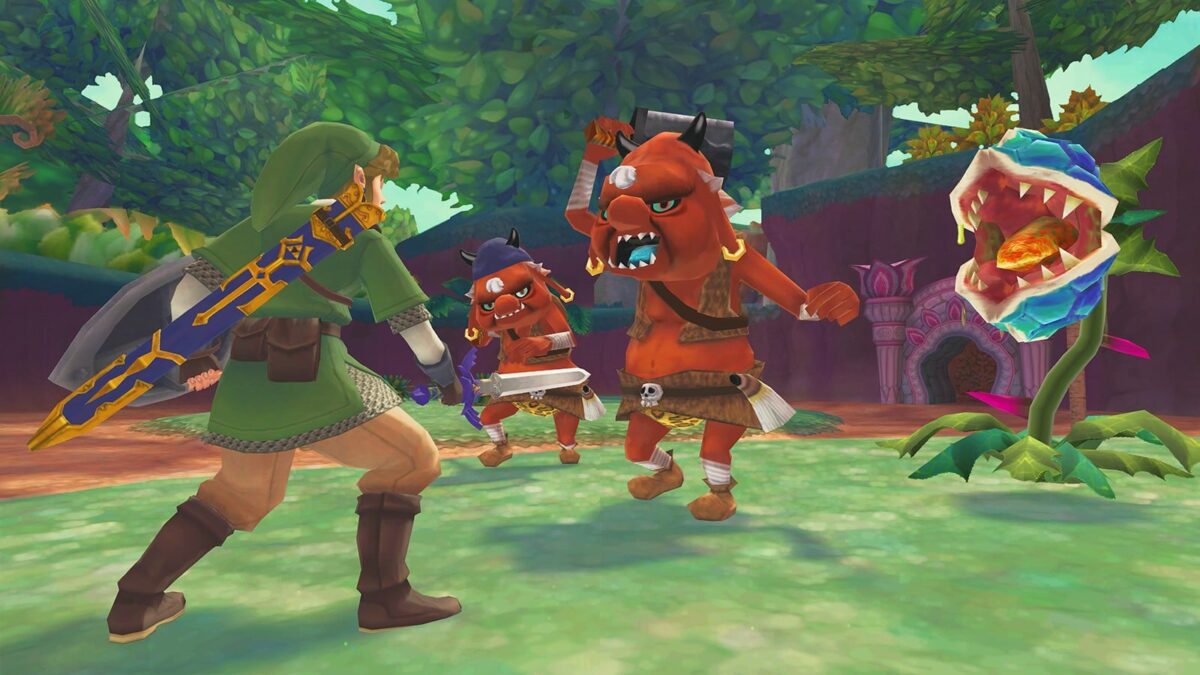The Legend of Zelda: Skyward Sword is my least favorite 3-D Zelda. It was released in 2011 at around the same time that The Elder Scrolls V: Skyrim did. Consequently, Skyward Sword gathered dust for months before I managed to finish it.
Out Dated Visuals
Skyrim looked amazing on the Xbox 360. Conversely, Skyward Sword looked like dated GameCube game. In fact, I remember being so underwhelmed that I felt that Twilight Princess had looked better 5 years earlier.
Now, Nintendo did perform wonders with the Wii hardware, a console that I have described before as an “overclocked Gamecube”. The Wii’s hardware is essentially 2001 technology, and its games certainly looked dated by 2011 (at that point we were two short years away from a new console generation).
In an effort to keep the game from looking dated, Nintendo made Skyward brighter, and more cartoonish than Twilight Princess. At the time, many described it as the happy medium between Wind Waker’s Cel shaded art style, and Twilight Princess’ realism.
The newest Zelda game, Breath of the Wild, seems to have followed Skyward Sword’s art direction to a large degree. This art style wasn’t my gripe with the game’s visuals. I just felt underwhelmed, and it might have been the first time that I had felt that way about a Zelda game.
The fact that I was playing the amazing Skyrim at the time didn’t help Skyward Sword either. Skyrim was the on the opposite spectrum of things. Bethesda’s game was a marked improvement over Oblivion, and its lush dense forested areas, and incredible mountain ranges were mesmerizing at the time.
Not Just the Dated Tech’s Fault

Aside from graphics, I just didn’t find Skyward Sword that much ‘fun’ and enthralling. Which again, is something that had never been an issue for me with a Zelda game on consoles.
For comparison’s sake, I played Twilight Princess at around the same time that I had purchased The Elder Scrolls IV: Oblivion. In 2006, even though Oblivion was pioneering brand new ‘HD’ graphics, and an incredible open-world engine that looked leaps and bounds beyond anything possible on the previous generation of consoles, Oblivion found itself collecting dust under my TV shelf, and Twilight Princess was the game that I found myself going back to on a daily basis.
Twilight Princess’ world had the right balance of that ‘magical’ Zelda feel, coupled with a nice dark tale, and the most captivating version of Hyrule that I had played up to that moment.
Twilight Princess, in many ways, felt like Ocarina of Time on steroids, and Ocarina of Time remains my favorite game of all time to this date. So, you can image just how special TP was for me.
Skyward Sword just couldn’t capture me in the same way.
Tired and True Zelda Formula With a Twist
While many Zelda purists have complained about Breath of Wild’s shrine system, and the game’s open nature, I found it refreshing and just what the series needed. I felt the series had hit the wall of stagnation with Skyward Sword.
As I played Skyward Sword, I wasn’t sure if Nintendo EAD had just lost its touch, had a bad day (by their incredible standards) at the office, or just plain focused too much on making the Wii’s motion controller work as an integral part of the game’s design.
I just didn’t have much fun with it. The dungeons were well designed, but ‘well’ is not a word I usually use when referring to Zelda’s dungeons.
A smaller world with less complex dungeons (when stacked against TP), made Skyward Sword a considerably less engaging experience for me. Even when compared to other rivaling games of its era (such as Fable 2, and 3).
One of the issues that made Skyward Sword a less than stellar experience for me was its use of motion controls as the game’s primary ‘gameplay’ driver.
Difficult Boss Fights Due to Imprecise Controls
The controls were accurate enough…as far as motion controls went, but they weren’t accurate enough to live up to Zelda’s penchant for precision. Some boss battles were more difficult that they needed to be thanks to the fact that I would deliver an incorrect sword strike while attempting to deliver the ‘correct’ strike in critical situations.
This issue would turn into a particularly frustrating experience during one of the final boss encounters.
There was also something odd about the game world’s design. I just didn’t feel compelled to collect heart pieces, which was another first for me on this series. There was a lot of backtracking and fetch questing needed in order to progress through the game’s story. Simply put, Skyward Sword became a tiring affair after 20 hours of play.
But not all was wrong with Skyward Sword. Nintendo EAD did make some positive strides in the game.
Orchestrated Music, and Emphasis in Storytelling
Skyward Sword did a great job in telling its story (even if its tale wasn’t my favorite), it made strides in dialog, and it did well selling Zelda’s ‘origin’ story. The story maintained a lighthearted feel throughout, and though it featured a larger interaction between Zelda and Link than in previous games, a true romance between the two never materialized.
Thus, as always, Nintendo makes it so that fans have to guess, and imply much of the story’s details in order to draw their own conclusions (and theories). In truth, this makes Zelda a fertile ground for fan fictions (and forum discussions), but at the same time, as a life long series’ fan; I am always left longing for more in regards to the series’ storytelling.
Finally, Skyward Sword introduced the series to Orchestrated music, and it sounded glorious at the time. Thankfully, Breath of the Wild kept the standard going strong.
The Legend of Zelda: Skyward Sword Remains a ‘Very Good’ Game

Despite my negative tone towards it, Skyward Sword is not bad game. Far from it, Skyward Sword is a very good game as my 8.5/10 rating of the game in my 2011 review shows, but when stacked against the rest of the series, and Skyrim I just didn’t find that it was better experience.
That 8.5 rating is the lowest score that I have given to a modern Zelda game, and it shows just how flawless Nintendo has been with this series throughout its 30 years plus lifespan, that I found massive disappointment in an 8.5/10 Zelda game.
Luckily, the game is getting a re-release/HD remaster (on July 16) for the Switch, and it seems that some of the hindrances (such as controls) have been tweaked or fixed. So, it should be worth another play through then.
Agree with the author? Couldn’t disagree more and are frothing at the mouth to tell him? Leave a comment here, on Facebook or send an email and make sure to follow Never Ending Realm on Facebook, Twitter, and YouTube!
